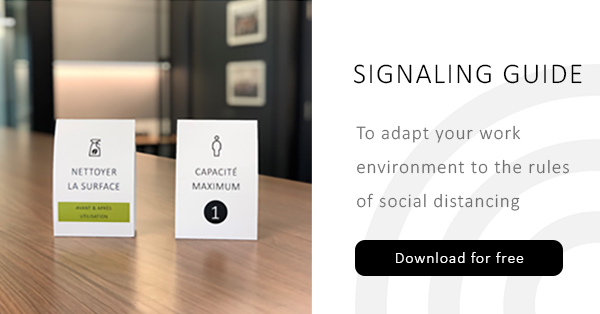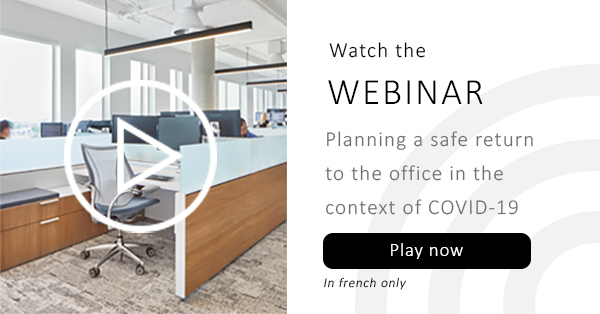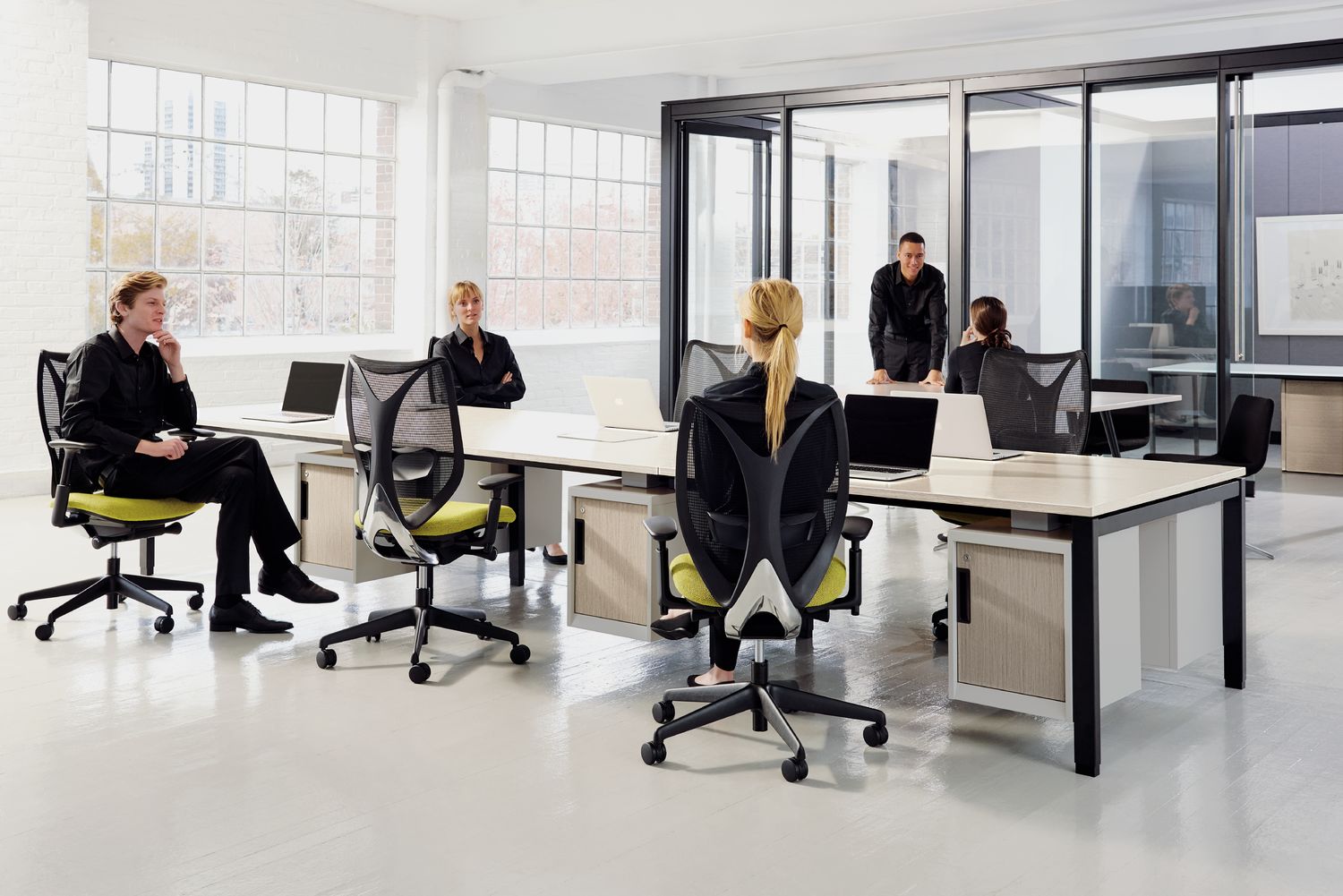
Plan a safe return to the office for your employees in the context of COVID-19
For many employees, going back to work means returning to the office after several months of teleworking in the wake of the pandemic that has been raging for the past few months.
However, calling back our resources to the office is not something that can be improvised in the situation we are experiencing. We have been called upon on several occasions to transform your offices into safe spaces and it is quite naturally that we came up with the idea of sharing with you a few thoughts on the solutions that can be implemented to help you in your reorganisation.
Of course, each company has its own “DNA”, and these solutions are not universal. However, we can help you make an advised choice of the best alternatives according to your company profile, your needs and your budget.
Consider the psychological and emotional condition of employees first and foremost.
In such a transition, the human factor must absolutely be at the heart of your reflections. The stakes, the feelings vary according to each person.
First of all, each human being has his or her own level of comfort with the possible exposure that a return to the office implies, and the repercussions that such a pathology could have on his or her health.
Also, in recent months, many people have suffered from the upheavals that forced telework has caused. For some, the work-family balance has been extremely difficult to manage and they will probably be pleased when things return to normal.
In short, each employee will experience this in his or her own way. The main thing is to stay tuned and take the pulse of your teams in order to find a solution that may need to be adapted as the case may be. Give them time to adapt, or the opportunity to decide on an eventual return.
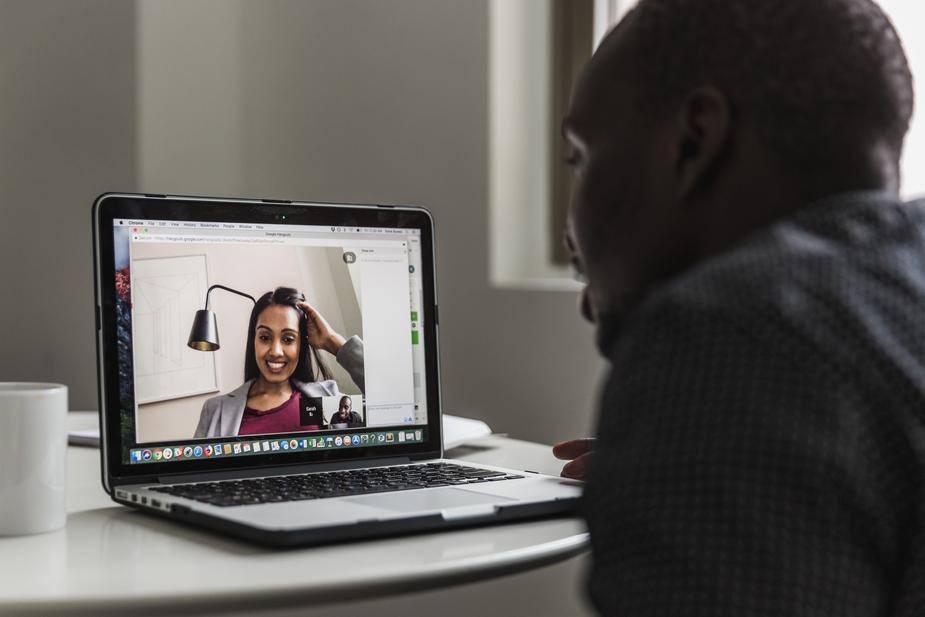
Teleworking
While teleworking was normal for some companies, for others the abrupt transition was much more complex to manage and they suffered from this new way of working that was imposed on them.
But telework is here to stay. It must now be part of your equation: shared office and home office, in case a second confinement would be necessary.
Defining eligible functions
Some types of positions are ideal for teleworking, while others require a presence in the office for operational or technical reasons. Roles and tasks will need to be considered when deciding whether or not to telework.
Provide functional and adapted equipment
Working from home cannot be improvised. An employee is responsible for having a conducive work environment at home. On the other hand, the employer must provide him/her with the equipment and technology necessary to perform his/her work in an efficient, safe and ergonomic manner.
We have set up purchasing programs so that companies can allow their employees to benefit from the purchase of ergonomic and adapted furniture, according to their budget.
Depending on their means, some companies choose to offer this equipment to their employees, or absorb part of the costs related to the purchase. This avoids additional stress for the employees, by being able to easily purchase furniture and accessories that are recognized for their superior quality and have ergonomic assets.
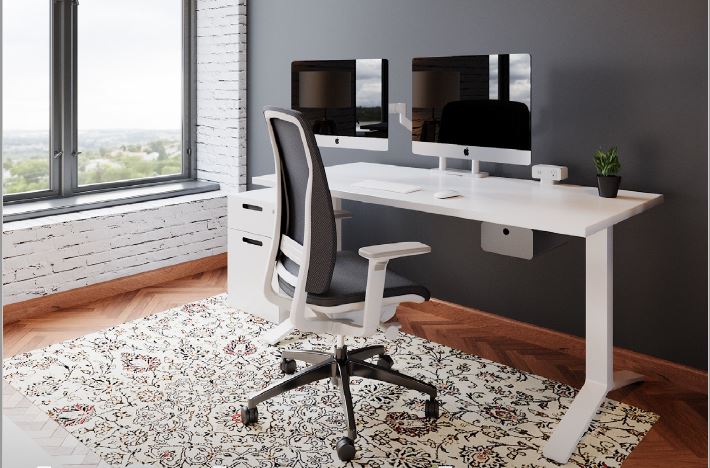
Put emphasis on communication
The only way to stay connected to your resources is through communication. So keep in touch via an instant exchange platform (such as Teams), take the pulse of your teams without falling into micromanagement, favoring sincere and regular exchanges.
Trust and confidence
Your performance management model may need to be adjusted. You can make sure that your team is performing and productive despite the lack of control that teleworking implies, based on the quality of the deliverables and the respect of deadlines. Trust your employees. Just because they’re not physically at the office doesn’t mean the work isn’t being done.
Moreover, when teleworking, the employee is less often disturbed and has a greater ability to concentrate. So, while they may spend a little less time sitting behind their desk because of family issues, the time spent in front is often more efficient.
Mutual trust is therefore necessary to successfully integrate this way of working.
The role your offices play
The office was until now for many people, the equivalent of a 2nd residence. We had taken it for granted, it was part of our habits. We got up every morning with the eternal “Metro, work, sleep” routine.
It was a pleasure to get together with our colleagues to talk about anything and everything. We enjoyed an incredible synergy.
But then came the coronavirus. During the next few months, the next year, maybe more, the office won’t be the same as it was before.
However, full-time teleworking is not ideal, and many will be happy to be able to go in the office again to connect with their colleagues, or to have access to hardware resources such as printers, hardware libraries, etc. The office will become a bit of their toolbox, and the place where they come to collaborate, share information and also the main attraction of the office: the atmosphere, quite simply.
The main challenge will therefore be to make our office attractive, and above all secure, so that everyone feels comfortable when they are present.
Office design
Redesigning an office in response to public health recommendations can be a real challenge, depending on the space available in the premises.
First of all, the social distancing factor must be considered: offices will need to be spaced further apart if the current configuration allows it, or seats will have to be condemned. Clearances will have to allow for fluid circulation in the office to limit contact between people.
If this is the time for you to invest in new furniture, flexible and easily configurable desks such as Teknion’s Cityline collection will be an enlightened choice and perfectly adapted to the situation.
In some cases, dividing screens will need to be installed. We recommend that you opt for quality equipment, which will certainly be more expensive, but also more beautiful, more functional, and above all, will last for many years.
In any case, be ready before your employees return to the office. Set up an internal sanitary policy that will be shared with everyone, and provide your employees with a sufficient number of disinfection stations.
Encourage them to keep their work surfaces as uncluttered as possible by offering them the possibility of storing their personal belongings in suitable storage (cubicles, changing rooms, etc.).
To do so, Groupe Focus has thought of everything, and provides you with a set of signage sheets to download for free!
Finally, survey your teams
It goes without saying that the first concerned should be heard. Take the pulse within your teams, be on the lookout for their slightest questions or concerns. Communication is an integral part of success in the game plan for a possible return to the office.
For example, you might ask them:
- How do you compare your level of concentration between home and the office?
- What do you miss most about the office?
- If you could take something from home to the office, what would it be? (And vice versa!)
Finally, listen, be curious, trust yourself, surround yourself with professionals who will find the best solutions for your situation and above all, be human!
You didn’t have the chance to attend our webinar “Planning a safe return to the office in the context of covid-19”?
It’s not too late! The presentation is available for viewing by clicking directly on the image below.

